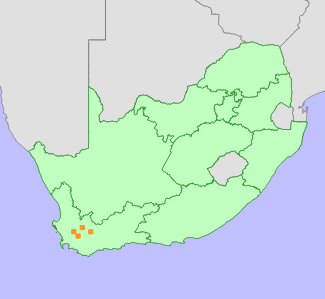|
Scientific Name | Drosanthemum worcesterense L.Bolus |
Higher Classification | Dicotyledons |
Family | AIZOACEAE |
National Status |
Status and Criteria | Endangered B1ab(iii)+2ab(iii) |
Assessment Date | 2018/10/03 |
Assessor(s) | L. von Staden |
Justification | Drosanthemum worcesterense is a range-restricted species with an extent of occurrence (EOO) of 2124 km². It has lost over 60% of its habitat to urban and agricultural expansion. Two to four severely fragmented subpopulations remain, and continue to decline due to ongoing habitat loss and degradation. It is therefore listed as Endangered under criterion B. |
Distribution |
Endemism | South African endemic |
Provincial distribution | Western Cape |
Range | This species is endemic to South Africa, and is found in the Breede River Valley between Tulbagh and Worcester and extends eastwards to Touwsrivier and Karoopoort. |
Habitat and Ecology |
Major system | Terrestrial |
Major habitats | Breede Shale Renosterveld, Matjiesfontein Shale Renosterveld, Breede Alluvium Renosterveld, Robertson Karoo |
Description | It occurs in stony clay soils in renosterveld. |
Threats |
| Critically little of this species' lowland renosterveld remains within the Breede River Valley, predominantly due to loss to agricultural expansion. Known subpopulations occur on isolated remnants, and continue to decline, particularly due to development around Worcester. Around Touwsrivier and Karoopoort, lowland renosterveld is extensively degraded due to overgrazing, and have also been ploughed in places. Drosanthemum species are highly palatable and decline rapidly in overgrazed areas. |
Population |
This species is known from only three collections in the last 30 years. Two of these localities are extremely small fragments where the subpopulations are unlikely to persist in the long term. Three more locations known through historical records need to be surveyed to determine if the species is still present in these areas. A continuing decline is inferred from ongoing habitat loss and degradation.
|
Population trend | Decreasing |
Assessment History |
Taxon assessed |
Status and Criteria |
Citation/Red List version | | Drosanthemum worcesterense L.Bolus | EN B1ab(iii)+2ab(iii) | 2020.1 | | Drosanthemum worcesterense L.Bolus | VU B1ab(i,ii,iii,iv,v) | 2017.1 | | Drosanthemum worcesterense L.Bolus | Threatened | Raimondo et al. (2009) | |
Bibliography |
Bolus, H.M.L. 1928-1935. Notes on Mesembrianthemum and allied genera. Part II. Bolus Herbarium, University of Cape Town, Cape Town.
Goldblatt, P. and Manning, J.C. 2000. Cape Plants: A conspectus of the Cape Flora of South Africa. Strelitzia 9. National Botanical Institute, Cape Town.
Manning, J.C. and Goldblatt, P. 2012. Plants of the Greater Cape Floristic Region 1: The Core Cape Flora. Strelitzia 29. South African National Biodiversity Institute, Pretoria.
Raimondo, D., von Staden, L., Foden, W., Victor, J.E., Helme, N.A., Turner, R.C., Kamundi, D.A. and Manyama, P.A. 2009. Red List of South African Plants. Strelitzia 25. South African National Biodiversity Institute, Pretoria.
|
Citation |
| von Staden, L. 2018. Drosanthemum worcesterense L.Bolus. National Assessment: Red List of South African Plants version . Accessed on 2025/09/11 |
 Comment on this assessment
Comment on this assessment


